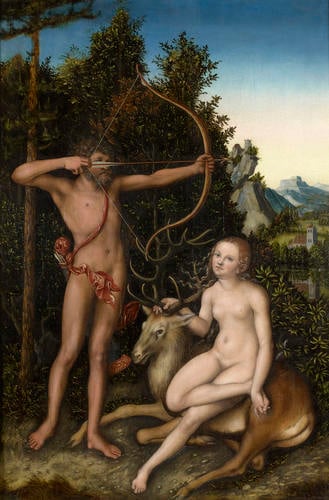-
1 of 253523 objects
Apollo and Diana c. 1526
Oil on beech panel | 84.6 x 57.2 cm (support, canvas/panel/stretcher external) | RCIN 407294
-
This painting is the outstanding work by Lucas Cranach the Elder (c.1472-1553) in the Royal Collection. It shows the sun god Apollo, admired for his moral standing and physical beauty, and his twin sister Diana or Artemis, goddess of the moon, who was associated with chastity, archery and hunting. The emphasis on humanity closely related to the primeval forest and hunting recalls Cranach's earlier work and the so-called Danube School. The scene is given a particular intensity by the way in which the figures are seen in relief but also related to the forest behind them. Diana's precisely rendered hair curls around the stag's antlers, which in turn are deliberately confused with the branches of the trees behind. Cranach's characteristically incisive clarity and attention to minute detail is seen here – for example, in the reflected light in the stag's eye or the small swans swimming on the lake.
Cranach may have already encountered the subject in Vienna. On 1 March 1501 the Emperor Frederick III and members of the nobility attended a performance of Ludus Dianae, a play by the humanist Conrad Celtis. In the court and scholarly circles in which Cranach moved at Wittenberg, Apollo would probably have been regarded as a forerunner of Christ and chaste Diana of the Virgin Mary, as well as mythological heroes. The decorative schemes at Wittenberg which have not survived brought together biblical, classical and mythological stories.
Diana's pose echoes that of the Antique bronze known as the Spinario (the 'thorn-remover', which shows a small boy pulling a thorn from the sole of his foot), though this source is much more apparent in a slightly later version in the Musée des Beaux-Arts, Brussels. Cranach also took ideas from prints of same subject by Jacopo de' Barbari and by Dürer, both dated c.1502-3, creating a new interpretation from these sources. In the final painting Cranach made very slight alterations to some contours for example, Apollo's legs, and his eyes and eyebrows, which were raised to be visible above the feathers of the arrow.
Prince Albert bought the painting as Adam and Eve, which is understandable since the protagonists have no obvious attributes and as nude types are very like those of Adam and Eve in the Garden of Eden, a subject which Cranach painted with many variations. Cranach intermingled sacred and secular motifs. A drawing of Adam and Eve (Museum Boijmans Van Beuningen, Rotterdam) may represent an intermediary stage between the Courtauld Adam and Eve and this painting. In it Eve is seated on a stag in a pose similar to that of Diana here. It is possible that Apollo and Diana and A faun and his family (J. Paul Getty Museum, Los Angeles) were painted as a pair because of similarities in composition, size and support. They may have been part of a larger group, painted c.1526, which formed a decorative scheme that included Adam and Eve (Courtauld Institute Gallery, London, dated 1526) and Cupid Complaining to Venus (National Gallery, London). The two later autograph versions of Apollo and Diana in the Gemäldegalerie, Berlin, dated 1530, and in the Musée des Beaux-Arts, Brussels, are each subtly different, illustrating the way in which Cranach's successful workshop varied ideas without exact repetition.
Signed with black winged serpent, lower left
Catalogue entry adapted from The Northern Renaissance. Dürer to Holbein, London 2011Provenance
Friedrich Campe, Nuremberg; from whom purchased by Ludwig Gruner for Prince Albert, June 1844 for £105
-
Creator(s)
Acquirer(s)
-
Medium and techniques
Oil on beech panel
Measurements
84.6 x 57.2 cm (support, canvas/panel/stretcher external)
99.7 x 72.8 cm (frame, external)
Category
Object type(s)
Alternative title(s)
Adam and Eve, previously entitled
